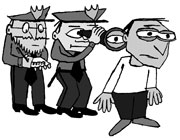FRANKLY, MY EXPECTATIONS of this book were not very high. After all, it was produced—OK, written—in three months by a 25-year-old minor media celebrity seeking to cash in before we all forget her. And just because a person can live in a tree doesn’t mean that person can write.
The Legacy of Luna: The Story of a Tree, a Woman, and the Struggle to Save the Redwoods
by Julia Butterfly Hill (Harper San Francisco, $25)
To be fair, Hill is not cashing in directly. Proceeds from her book are going to the Circle of Life Foundation, the pseudo-mystic 501(c)3 that she has set up to help save redwoods by unclear means. And the book, like her story itself, is in places quite compelling. In case you missed it, Hill is the unseasoned environmental activist who, in late 1997, climbed into a 200-foot-tall redwood (christened “Luna,” hence the book title) near Stafford, California. Remarkably, she wound up staying there for over two years, defying foul weather, timber-company harassment, and her own crises in faith.
But there’s only so much narrative glory one can extract from sitting, for months on end, in a 6- by 8-foot space, even if it is 180 feet off the ground. (There’s talk of making a movie out of Hill’s stunt, too. How?) To fill the gaps, the book turns, much as Hill did herself during her lonely perch, to a most cloying sort of eco-mysticism, sincerely felt but bound to alienate all but the tree-worshippers, stereotypes whose images some environmental activists have worked decades to erase. It’s difficult to imagine Aldo Leopold, to pick one random example, giving himself a “forest name” (that’s where “Butterfly” comes from), naming his favorite tree, and then unleashing a passage like the following:
“Living in a tree this size, I felt balanced right at the center of Creation, the way we are all balanced at the center of Creation. I learned firsthand how everything that we can—or cannot—see is interconnected like strands in this web of life, from the microorganisms in the soil helping feed nutrients to Luna, to the stars that are billions of light years away, and everything in between. Living the way I live, I’ve learned how each thread reaches back to us.”
Pronouncements like these are why the more credulous among forest activists, as the sit wore on, started referring to the “teachings” of Butterfly—as though sitting in a tree for two years gives a person special insight into the human condition. A little of this goes a long way.
CURIOUSLY, HILL doesn’t spend much time laying out the case for why the redwoods should be saved—why, for example, they are a unique and invaluable ecosystem—or how it could be done. What we get instead is a poorly written but heartfelt, People magazine-level account of two years in a tree. Aside from her remarkable tenacity and physical accomplishment, it’s clear that she doesn’t have much to offer this debate beyond the catch phrases she learned after she started her tree-sit.
“Not until months later [after the tree-sit began] would I educate myself on every matter relating to sustainable forestry.” In one phrase, Hill acknowledges that she started out knowing little beyond her newly found love of the redwoods—and implies that one can “educate on every matter” while sitting in a tree, something of an insult to timber workers who spend their lives in pursuit of such an education. She notes that “On my very first day in Luna . . . I didn’t really know the difference between old growth and ancient growth.” Five pages later she uses the two as synonyms.
Hill also deals cursorily with the controversy surrounding her agreement to pay Pacific Lumber $50,000 to “save” Luna after her descent. The Circle of Life Foundation’s press release after the agreement, which echoes Hill’s own statements, concluded: “The Luna Preservation agreement symbolizes hope that a new era of peace and cooperation has begun and that bridges can be built between the timber industry and environmentalists, between corporations and communities.” Maybe. But to others the agreement represented a skilled corporate negotiator taking advantage of a naive tree-sitter.
So, what’s left is the story. In it is a valuable lesson—that any one person can make a difference with her or his actions. Also in it are sketches and bad poetry:
Still Up Here
I sit here
Swaying in the gusting wind
Watching the winter rains
Nourishing the thirsty land
I sit here
For over one year now
Length of time has lost its meaning
To my ever-evolving mind
Hill will accomplish a lot more in her life; but, based on this book, she is not the most gifted political spokeswoman for her cause. It’s not surprising—it’s more than sufficient to do what she’s done.







